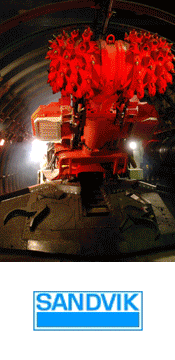Jumbos drive Malaysia's rail connector
Jan 2011
By TunnelTalk
- Two Sandvik jumbos were at the front end of drill+blast excavation of the longest rail tunnel in South East Asia. Main contractor MMC-Gamuda used two of Sandvik's top of the range drilling rigs, two DT820-SC jumbos, for rock drilling on the 2.2km long twin tube Berapit rail tunnel in Malaysia.
-

One of two Sandvik DT820-SC jumbos ready to attack
- The twin tube tunnel is part of Malaysia's project to double-track and electrify the 329km long Ipoh to Padang Besar line, which is due to be completed by end-2011. The project also involves construction of 65 overhead roads, eight road bridges, 75 river bridges and 43 bridges for motorcycles and pedestrians.
- Tunnelling by main contractor MMC-Gamuda and its OTA Tunnel Squad as tunnelling sub-contractor began in October 2009 with a jumbo each deployed in each tunnel tube. Breakthrough on the left tunnel took place on October 1, 2010, with breakthrough on the right tunnel following exactly a month later, on November 1 to finish all excavation 55 days ahead of schedule.
- Sandvik DT820-SC jumbo drills are hydraulic two-boom machines able to drill a cross-section of 12-110m2. They are equipped with cabins and TCAD instrumentation, providing drill bit positions and a feed direction measurement system and each jumbo is equipped with a 45mm diameter Sandvik RT300 button bit and 4.9m T38-H35-R32 drifter rods.
-

The jumbos worked full-face 8m high x 7m wide faces
- The two tunnel portals are at an elevation of 65m above sea level and have been built at a gradient of 25m. At 8m high x 7m wide, the tunnels represent a total tunnel length of 4,482m and have a face area of between 50m-60m2.
- Mr Kana, Managing Director of OTA Tunnel Squad, said the tunnellers carried out full face cross section drill+blast excavation drilling between 70 and 90, 4.9m deep charge holes per round.
- The jumbos took about one minute to drill 1.5-2m of rock on average, which was 2.4-2.6 density granite of greatly variable hardness, ranging from 50 to 200 MPa with the hardest section being a stretch of about 300m. Working on a 24/7 basis and using ANFO explosive cartridges, the contractor operated two 10hr shifts with an average 1.5 rounds per shift. Pull per 4.9m round was between 3.8m and 4m, with the highest advance rate being 516m in a one-month period.
-

View of a completed 2.2km long railway connector
- The tunnel also has nine cross passages 30-35m2 at 350m intervals.
- Mr Kana says the drill bits were rebored on site after between 300 and 350 drilled metres, a process that added between 10-15% to the service life of the bits.
- Total volume of rock and soil excavated on the two tunnels was 1.32 million tones and the total tunnelling days amounted to 1,032. Peak manpower on site was 240.
- One of the Sandvik DT820 machines was used earlier on the project's Larut Tunnel near Taiping. which was completed in November 2009.
- Record rail tunnel break through in Malaysia - TunnelTalk, Nov 2010
|
|
|
|
|
Add your comment
- Thank you for taking the time to share your thoughts and comments. You share in the wider tunnelling community, so please keep your comments smart and civil. Don't attack other readers personally, and keep your language professional.

